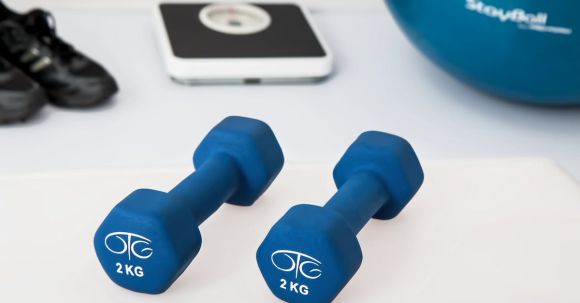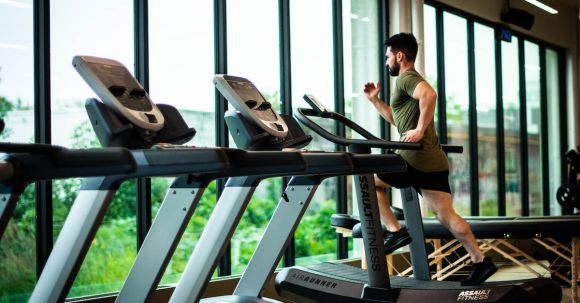Embarking on a fitness journey can be both exciting and challenging. Whether you are trying to lose weight, build muscle, or improve your overall health, staying motivated is crucial for long-term success. Here are some effective strategies to help you maintain your motivation throughout your fitness journey.
Blog Posts
Athletes are constantly looking for ways to improve their performance and gain a competitive edge. While regular exercise is important for overall fitness, sports-specific exercises can take your training to the next level. By targeting the specific muscles and movements used in your sport, you can enhance your skills and achieve greater success on the field, court, or track. In this article, we will explore the benefits of sports-specific exercises and provide some examples for various sports.
Basketball: Jump Higher, Run Faster
Basketball is a fast-paced sport that requires explosive jumping and quick bursts of speed. To improve your vertical leap, incorporate plyometric exercises like box jumps and squat jumps into your routine. These exercises help develop the leg muscles needed for powerful jumps. To enhance your speed and agility, focus on drills that involve quick changes of direction, such as ladder drills or cone drills. By incorporating these sports-specific exercises into your training, you can elevate your game to new heights.Football: Power and Agility
Football players need a combination of power, speed, and agility to excel on the field. To build explosive power, include exercises like power cleans and kettlebell swings in your workouts. These exercises target the muscles used in explosive movements, such as jumping and tackling. For agility, incorporate ladder drills and shuttle runs into your training. These drills simulate the quick changes of direction that are common in football games. By incorporating these sports-specific exercises into your routine, you can become a formidable force on the gridiron.Tennis: Improve Your Swing
Tennis is a sport that requires a strong upper body and quick footwork. To improve your swing, incorporate exercises that target the muscles used in the motion, such as medicine ball throws and cable rotations. These exercises help develop the rotational power needed for a powerful serve or forehand. Additionally, footwork drills like ladder drills and agility ladder exercises can improve your speed and agility on the court. By adding these sports-specific exercises to your training regimen, you can become a more formidable opponent on the tennis court.Running: Boost Endurance and Speed
For runners, endurance and speed are key. To improve your endurance, incorporate long-distance runs into your training routine. Gradually increase the distance of your runs to build up your stamina. Interval training is also beneficial for improving speed. Alternate between periods of high-intensity sprints and recovery periods of slower jogging or walking. This will help improve your anaerobic capacity and overall speed. By incorporating these sports-specific exercises into your running routine, you can take your performance to the next level.Conclusion: Elevate Your Game
Sports-specific exercises are a valuable tool for athletes looking to improve their performance. By targeting the specific muscles and movements used in your sport, you can enhance your skills and achieve greater success. Whether you play basketball, football, tennis, or any other sport, incorporating these exercises into your training routine can help you elevate your game. So, lace up your shoes, grab your racket, or put on your helmet, and get ready to train for success.
In today's digital age, online personal training has become increasingly popular among fitness enthusiasts. With its convenience and flexibility, it allows individuals to work towards their fitness goals from the comfort of their own homes. However, to truly maximize results with online personal training, there are a few key strategies to keep in mind. In this article, we will explore these strategies and provide practical tips to help you get the most out of your online training experience.
Set Clear and Specific Goals
Before embarking on any fitness journey, it is essential to establish clear and specific goals. This holds true for online personal training as well. By defining what you want to achieve, you can tailor your training program accordingly. Whether your goal is to lose weight, build muscle, or improve overall fitness, having a clear objective will help you stay focused and motivated throughout the process.Choose the Right Online Personal Trainer
With countless online personal trainers available, it is crucial to choose one who aligns with your goals and preferences. Take the time to research and read reviews from previous clients. Look for trainers who have experience and expertise in your specific area of interest. Additionally, consider their communication style and availability. A trainer who provides regular feedback and support will greatly enhance your training experience.Establish a Structured Training Schedule
Consistency is key when it comes to online personal training. Without a set schedule, it is easy to fall into the trap of skipping workouts or procrastinating. To maximize results, establish a structured training schedule and stick to it. Treat your online training sessions as you would an in-person session, prioritizing them in your daily routine. Setting aside specific times for workouts will help you stay accountable and ensure that you are consistently working towards your goals.Utilize Technology and Tracking Tools
One of the advantages of online personal training is the utilization of technology. Take full advantage of this by utilizing various tracking tools and fitness apps. These tools can help you monitor your progress, track your workouts, and provide valuable data to both you and your trainer. By regularly reviewing your progress and making necessary adjustments, you can optimize your training program for maximum results.Stay Engaged and Communicate
Unlike in-person training, online personal training requires proactive engagement and regular communication with your trainer. Make an effort to stay engaged by asking questions, seeking clarification, and providing feedback. Your trainer is there to guide and support you, but they rely on your input to tailor the program to your needs. Effective communication ensures that you are getting the most out of your training sessions.Stay Accountable and Motivated
With online personal training, it is essential to stay accountable and motivated on your own. While your trainer can provide guidance and support, ultimately, it is up to you to put in the effort and stay committed. Find ways to keep yourself motivated, whether it is setting small milestones, rewarding yourself for reaching goals, or finding an accountability partner. By staying accountable and motivated, you will be more likely to maximize your results. In conclusion, online personal training offers a convenient and effective way to achieve your fitness goals. By setting clear goals, choosing the right trainer, establishing a structured schedule, utilizing technology, staying engaged, and remaining accountable, you can maximize your results and make the most of your online training experience. Remember, the key is consistency and dedication. So, embrace the flexibility and convenience of online personal training and embark on a fitness journey that will transform your life.
In today's fast-paced world, finding time to go to the gym or attend fitness classes can be challenging. However, achieving a healthy body weight doesn't necessarily require a gym membership or expensive equipment. With the right mindset and a few simple strategies, you can achieve your weight loss goals from the comfort of your own home.
Create a Dedicated Workout Space
Having a dedicated workout space in your home can help you stay focused and motivated. Find an area that is free from distractions and clutter, and set it up with a yoga mat, resistance bands, and any other equipment you may need. Having a designated space will make it easier to commit to regular workouts and avoid the temptation of skipping them.Make a Schedule and Stick to It
Creating a workout schedule and sticking to it is crucial for achieving a healthy body weight. Treat your workouts as important appointments that cannot be missed. Whether you prefer to exercise in the morning or evening, find a time that works best for you and commit to it. Consistency is key when it comes to reaching your weight loss goals.Mix Up Your Workouts
Doing the same workout routine day after day can quickly lead to boredom and decreased motivation. To keep things interesting and prevent plateau, mix up your workouts. Incorporate a variety of exercises such as cardio, strength training, and flexibility exercises. Not only will this help you burn more calories, but it will also target different muscle groups, leading to a more balanced and toned physique.Utilize Online Workouts and Fitness Apps
Thanks to the internet and technology, there is a wide range of online workouts and fitness apps available that can help you achieve a healthy body weight. From yoga and Pilates to high-intensity interval training (HIIT) and dance workouts, there is something for everyone. Experiment with different workouts and find what you enjoy the most. Having a variety of options at your fingertips will help you stay motivated and engaged in your fitness journey.Set Realistic Goals
When it comes to achieving a healthy body weight, setting realistic goals is key. Avoid setting unrealistic expectations that are impossible to achieve. Instead, set small, achievable goals that you can work towards. Celebrate each milestone along the way, as this will help keep your motivation high and prevent feelings of discouragement.Practice Mindful Eating
Achieving a healthy body weight is not just about exercise; it also involves adopting healthy eating habits. Mindful eating is a practice that involves paying attention to your food and eating habits, without distractions. This means sitting down at a table, savoring each bite, and listening to your body's hunger and fullness cues. Avoid mindless snacking in front of the TV or computer, as this can lead to overeating and weight gain.Stay Hydrated
Drinking enough water throughout the day is essential for overall health and can also aid in weight loss. Water helps to flush out toxins, boost metabolism, and keep you feeling full. Aim to drink at least eight glasses of water per day, and if you find plain water boring, try infusing it with fruits or herbs for added flavor.Incorporate Movement Into Your Daily Routine
Achieving a healthy body weight is not just about structured workouts; it's also about incorporating movement into your daily routine. Take the stairs instead of the elevator, go for a walk during your lunch break, or do a quick workout video during your TV commercial breaks. Finding ways to move more throughout the day will help increase your calorie burn and assist in weight loss.Conclusion
Achieving a healthy body weight from home is not only possible but also convenient and cost-effective. By creating a dedicated workout space, making a schedule, mixing up your workouts, utilizing online resources, setting realistic goals, practicing mindful eating, staying hydrated, and incorporating movement into your daily routine, you can reach your weight loss goals without ever leaving the comfort of your own home. Remember, consistency and determination are key to achieving long-lasting results.
In today's fast-paced world, it's becoming increasingly important to maintain a high level of endurance to keep up with the demands of daily life. Whether you're an athlete looking to improve your performance or simply someone who wants to feel more energized throughout the day, incorporating home exercises into your routine can help you increase your endurance and overall fitness. In this article, we will explore a variety of home exercises that can be easily done to boost your endurance without the need for a gym membership or expensive equipment.
Interval Training: The Key to Building Endurance
Interval training is a highly effective method for increasing endurance and improving cardiovascular fitness. This type of training involves alternating between periods of high-intensity exercise and periods of rest or lower intensity. By pushing your body to its limits and then allowing it to recover, you can gradually increase your endurance over time.High-Intensity Interval Training (HIIT): A Time-Saving Option
HIIT workouts are a popular form of interval training that can be done at home with minimal equipment. These workouts typically involve short bursts of intense exercise followed by short periods of rest. For example, you could perform 30 seconds of high-intensity exercises such as burpees or jumping jacks, followed by 30 seconds of rest. Repeat this cycle for 10-20 minutes, and you'll be amazed at how quickly your endurance improves.Bodyweight Exercises: No Equipment Required
One of the great advantages of home exercises is that they often require little to no equipment. Bodyweight exercises, in particular, can be highly effective for building endurance. Squats, lunges, push-ups, and mountain climbers are just a few examples of bodyweight exercises that can be easily incorporated into a home workout routine. These exercises not only improve endurance but also help to build strength and tone muscles.Circuit Training: A Full-Body Workout
Circuit training involves moving quickly from one exercise to the next, targeting different muscle groups in each circuit. This type of training not only helps to increase endurance but also provides a full-body workout. You can create your own circuit by combining various bodyweight exercises or by using household items such as chairs or water bottles as weights. Aim to perform each exercise for a set amount of time or number of repetitions before moving on to the next.Jumping Rope: A Fun and Effective Cardio Exercise
Jumping rope is a classic exercise that can be done almost anywhere, including the comfort of your own home. This simple yet effective cardio exercise not only improves endurance but also helps to strengthen the cardiovascular system and burn calories. Start with short intervals of jumping rope, gradually increasing the duration as your endurance improves. You can also incorporate variations such as alternating feet, double unders, or high knees to keep things interesting.Stay Consistent and Listen to Your Body
While these home exercises can be highly effective for increasing endurance, it's important to stay consistent and listen to your body. Start with shorter workout sessions and gradually increase the duration and intensity as you progress. Be mindful of any discomfort or pain and adjust your exercises accordingly. Remember, building endurance takes time, so be patient and celebrate your progress along the way. Incorporate these home exercises into your routine and watch as your endurance improves. Whether you choose to do interval training, bodyweight exercises, circuit training, or jumping rope, the key is to stay consistent and push yourself to new limits. With dedication and perseverance, you'll be amazed at how much your endurance improves, allowing you to tackle life's challenges with ease. So, what are you waiting for? Lace up your sneakers, clear some space in your living room, and get ready to increase your endurance with these home exercises.
When it comes to improving your performance in any sport, simply going through the motions at the gym won't cut it. To truly excel, you need to incorporate sports-specific exercises into your training routine. These exercises are designed to target the specific muscles and movements required for your chosen sport, helping you build strength, power, and agility in a way that translates directly to improved performance on the field or court.
Football: Mastering the Field
Football is a game of explosive power, agility, and endurance. To take your training to the next level, focus on exercises that mimic the movements and demands of the sport. Incorporate exercises such as shuttle runs, ladder drills, and box jumps to improve your agility and quickness. To develop explosive power, incorporate plyometric exercises like squat jumps and medicine ball throws. Finally, don't forget to include plenty of cardiovascular training to build endurance and stamina.Basketball: Rise Above the Rim
Basketball is a sport that requires a combination of speed, agility, and vertical jump. To become a better basketball player, incorporate exercises that focus on these areas. Jump training exercises like depth jumps, box jumps, and split squats can help you increase your vertical jump, allowing you to rise above the rim. Combine these with lateral quickness drills such as cone hops and agility ladder exercises to improve your side-to-side movement and defensive skills. End your workouts with high-intensity interval training to improve your cardiovascular endurance and replicate the demands of the game.Tennis: Dominate the Court
Tennis is a sport that demands quickness, agility, and explosive power. To enhance your performance on the court, incorporate exercises that target these areas. Plyometric exercises like lateral bounds and single-leg hops can help improve your explosive power and quickness. Incorporate exercises that mimic the rotational movements of the sport, such as medicine ball twists and cable woodchops, to improve your agility and core strength. Don't forget to include exercises that target your upper body, such as push-ups and rows, to improve your strength and racket control.Golf: Perfect Your Swing
Golf is a sport that requires a combination of strength, flexibility, and coordination. To take your golf game to the next level, incorporate exercises that focus on these areas. Perform exercises that target your core, such as planks and Russian twists, to improve your stability and rotational power. Incorporate exercises that target your glutes and hips, such as hip bridges and lateral lunges, to improve your lower body strength and generate power in your swing. Finally, don't forget to include flexibility exercises, such as yoga or Pilates, to improve your range of motion and prevent injuries.Conclusion: Elevate Your Performance
By incorporating sports-specific exercises into your training routine, you can take your performance to new heights. Whether you're a football player looking to dominate the field, a basketball player aiming to rise above the rim, a tennis player seeking to dominate the court, or a golfer looking to perfect your swing, there are exercises that can help you achieve your goals. So, don't settle for average. Take your training to the next level with sports-specific exercises and elevate your performance to new heights.
Cardiovascular exercises, also known as cardio or aerobic exercises, are an essential part of any fitness routine. These exercises increase the heart rate, strengthen the cardiovascular system, and improve overall health and fitness. If you're a beginner looking to incorporate cardio into your workout routine, this guide will provide you with the necessary information to get started.
Understanding Cardiovascular Exercises
Cardiovascular exercises are activities that increase your heart rate and breathing rate over an extended period. The primary goal of these exercises is to improve the efficiency of your heart and lungs, allowing them to supply oxygen-rich blood to your muscles more effectively. Examples of cardiovascular exercises include running, cycling, swimming, dancing, and brisk walking.The Benefits of Cardiovascular Exercises
Engaging in regular cardiovascular exercises offers numerous benefits for both your physical and mental health. Some of the key benefits include: 1. Improved heart health: Cardio exercises strengthen your heart muscles, reducing the risk of heart diseases such as heart attacks and strokes. 2. Weight management: Cardio exercises help burn calories and fat, aiding in weight loss and weight management. 3. Increased endurance: Regular cardio workouts enhance your stamina and endurance levels, allowing you to perform daily activities with less fatigue. 4. Mental well-being: Cardio exercises release endorphins, also known as "feel-good" hormones, promoting a positive mood and reducing stress and anxiety.Getting Started with Cardiovascular Exercises
Before beginning any new exercise program, it's important to consult with your healthcare provider, especially if you have any underlying health conditions. Once you have the green light, follow these steps to incorporate cardiovascular exercises into your routine: 1. Start slow: If you're a beginner, begin with low-impact exercises such as brisk walking or cycling. Gradually increase the intensity and duration of your workouts as your fitness level improves. 2. Choose activities you enjoy: Find activities that you enjoy doing, as this increases the likelihood of sticking to your exercise routine. Whether it's dancing, swimming, or playing a sport, make it fun! 3. Set realistic goals: Set achievable goals that align with your fitness level. For example, aim to walk for 30 minutes three times a week and gradually increase the time or intensity as you progress. 4. Mix it up: Incorporate a variety of cardiovascular exercises into your routine to keep things interesting and challenge different muscle groups. This can help prevent boredom and improve overall fitness. 5. Monitor your intensity: Pay attention to your heart rate during workouts. Aim to reach a moderate intensity level, where you can still hold a conversation but feel slightly breathless. 6. Stay hydrated: Drink plenty of water before, during, and after your workouts to stay hydrated and maintain optimal performance.Tracking Your Progress
To stay motivated and track your progress, consider using fitness apps or devices that monitor your heart rate, distance covered, and calories burned. These tools can provide valuable insights into your workout sessions and help you set new goals to keep improving. Incorporating cardiovascular exercises into your fitness routine is a fantastic way to improve your overall health and well-being. Remember to start slow, choose activities you enjoy, and set realistic goals. With consistency and dedication, you'll soon experience the incredible benefits of cardiovascular exercises. So lace up your sneakers, dive in, and begin your journey towards a healthier, fitter you!
Who doesn't want a firm and well-toned booty? While hitting the gym or attending a fitness class may not always be feasible, you can still work on sculpting your glutes right from the comfort of your own home. With a little bit of dedication and the right exercises, you can achieve the desired results without any fancy equipment. So, let's dive right into it and discover some effective ways to tone your glutes from home.
The Power of Squats
Squats are a classic exercise that targets your glute muscles. They are highly effective in building strength and adding definition to your booty. To perform a squat, stand with your feet shoulder-width apart, lower your body by bending your knees, and push your hips back as if you are sitting on an imaginary chair. Keep your chest up and your core engaged. Return to the starting position by driving through your heels. Repeat this exercise for a total of 3 sets, with 10 to 15 repetitions per set.Lunges for a Sculpted Booty
Lunges are another fantastic exercise that works wonders for your glutes. They target the muscles in your hips, thighs, and buttocks, making them an excellent choice for toning your lower body. Start by standing with your feet hip-width apart. Take a step forward with your right foot and lower your body until your right knee is bent at a 90-degree angle. Push through your right heel to return to the starting position. Repeat on the other side. Aim for 3 sets of 12 to 15 repetitions on each leg.Bridge Pose for Glute Activation
The bridge pose is an effective exercise for glute activation. Lie on your back with your knees bent and your feet flat on the floor, hip-width apart. Place your arms by your sides. Lift your hips off the ground, squeezing your glutes as you go. Hold the position for a few seconds and then slowly lower your hips back down. Repeat for a total of 3 sets with 12 to 15 repetitions.Fire Hydrants to Target Your Gluteus Medius
The gluteus medius is an important muscle that helps with hip stability and overall glute strength. Fire hydrants are a great exercise to specifically target this muscle. Start on all fours with your hands directly under your shoulders and your knees under your hips. Keeping your knee bent, lift your right leg out to the side, as if you were a dog lifting its leg on a fire hydrant. Return to the starting position and repeat on the other side. Aim for 3 sets of 12 to 15 repetitions on each leg.Donkey Kicks for a Booty Burn
Donkey kicks are an excellent exercise for targeting the glutes and getting that burn. Start on all fours with your hands directly under your shoulders and your knees under your hips. Keeping your knee bent, lift your right leg up towards the ceiling, squeezing your glutes at the top of the movement. Slowly lower your leg back down and repeat on the other side. Aim for 3 sets of 12 to 15 repetitions on each leg.Consistency is Key
To see results and achieve a toned booty, it's important to stay consistent with your workouts. Aim to perform these exercises at least three times a week and gradually increase the intensity as you get stronger. Remember to always listen to your body and give yourself rest days to recover. In conclusion, toning your glutes from home is completely doable with the right exercises and dedication. Incorporate squats, lunges, bridge pose, fire hydrants, and donkey kicks into your routine to target and sculpt your glute muscles. Stay consistent, be patient, and watch your booty transform over time. Get ready to rock those jeans with confidence!
Strength training is a popular form of exercise that involves the use of resistance to build strength, increase muscle mass, and improve overall fitness. While it is important to have a well-designed exercise program, nutrition also plays a crucial role in supporting strength training goals. In this article, we will explore the key aspects of nutrition that are essential for maximizing the benefits of strength training.
Fueling Your Workouts
One of the primary goals of strength training is to challenge your muscles to the point of fatigue, which triggers muscle growth and strength gains. To perform at your best during these workouts, it is important to provide your body with the necessary fuel. This means consuming enough calories to meet your energy needs, with a focus on nutrient-dense foods.Protein for Muscle Repair and Growth
Protein is often referred to as the building block of muscle, and for good reason. It is essential for muscle repair and growth, making it a key nutrient for strength training. Including high-quality protein sources in your diet, such as lean meats, poultry, fish, eggs, and plant-based options like beans and tofu, can help support muscle recovery and promote muscle protein synthesis.Carbohydrates for Energy
Carbohydrates are the body's primary source of energy, and they play a crucial role in fueling strength training workouts. Consuming an adequate amount of carbohydrates before and after your workouts can help optimize your performance and support muscle glycogen replenishment. Opt for complex carbohydrates like whole grains, fruits, and vegetables, which provide a steady release of energy and are rich in essential nutrients.Fats for Hormone Production
While fats have long been demonized, they are an essential part of a healthy diet, especially for those engaged in strength training. Fats provide a concentrated source of energy and are crucial for hormone production. Including healthy fats, such as avocados, nuts, seeds, and olive oil, in your diet can help optimize hormone levels and support overall health and performance.Hydration for Performance
Staying hydrated is often overlooked but is a crucial aspect of nutrition for strength training. Dehydration can negatively impact performance and impair muscle function. Make sure to drink enough water throughout the day, and especially before, during, and after your workouts. Additionally, if you are engaging in intense or prolonged exercise, consider replenishing electrolytes lost through sweat with sports drinks or electrolyte-enhanced water.Timing of Meals and Snacks
In addition to considering what you eat, it is also important to think about when you eat. Timing your meals and snacks strategically can help optimize your performance and recovery. Consuming a balanced meal or snack containing protein and carbohydrates within the hour before and after your workouts can provide your muscles with the necessary nutrients for repair and growth.Monitoring and Adjusting
Lastly, it is important to remember that nutrition is not a one-size-fits-all approach. Everyone's nutritional needs may vary depending on factors such as age, gender, body composition, and individual goals. Monitoring your progress and making adjustments to your nutrition plan as needed can help maximize the benefits of strength training and optimize your overall health and well-being. In conclusion, nutrition plays a crucial role in supporting strength training goals. Fueling your workouts with the right balance of macronutrients, including protein, carbohydrates, and fats, can help optimize performance, promote muscle growth, and aid in muscle repair. Additionally, staying hydrated and timing your meals and snacks strategically are important considerations for maximizing the benefits of strength training. By paying attention to your nutrition and making adjustments as needed, you can enhance your strength training journey and achieve your desired results.
Every athlete knows that to excel in their chosen sport, they need to have a strong and well-conditioned body. While regular exercise is beneficial for overall fitness, it is important to specifically train the muscles and skills required for your sport. This is where sports-specific workouts come into play. By tailoring your training to the demands of your sport, you can maximize your performance and minimize the risk of injury. In this article, we will explore the benefits of sports-specific workouts and provide some examples for various sports.









